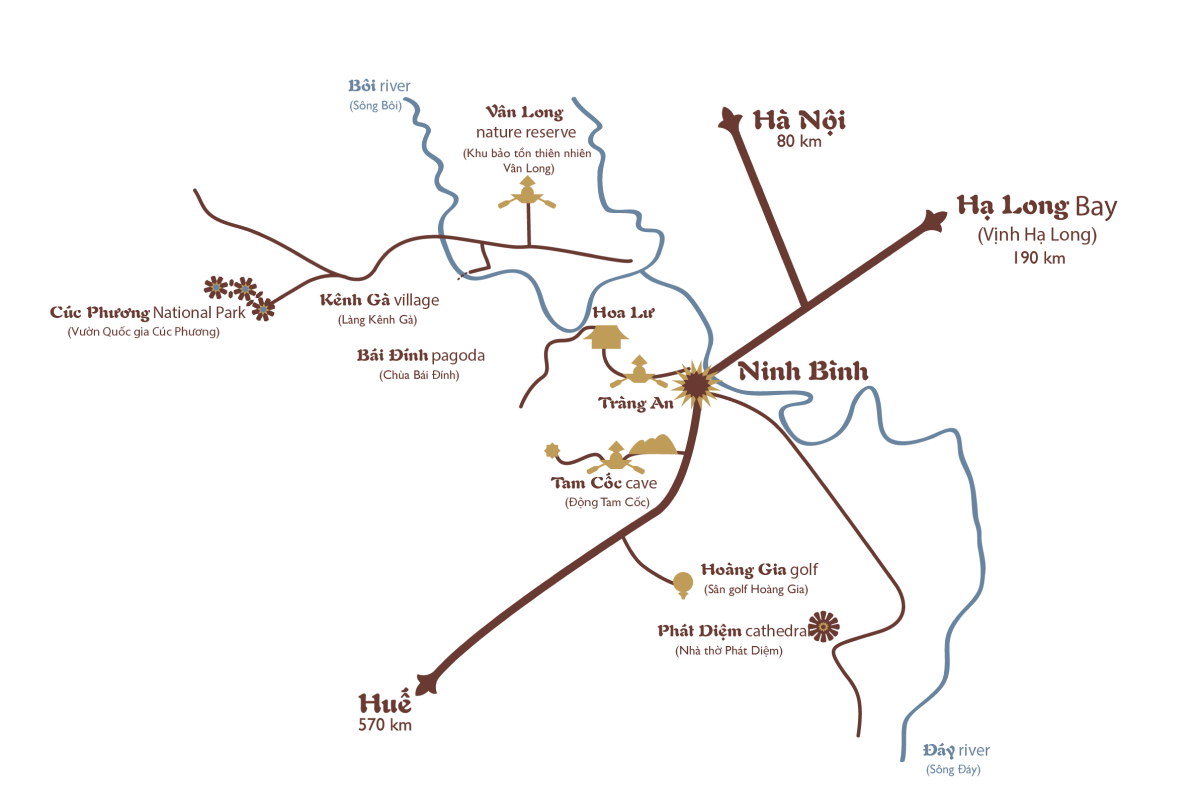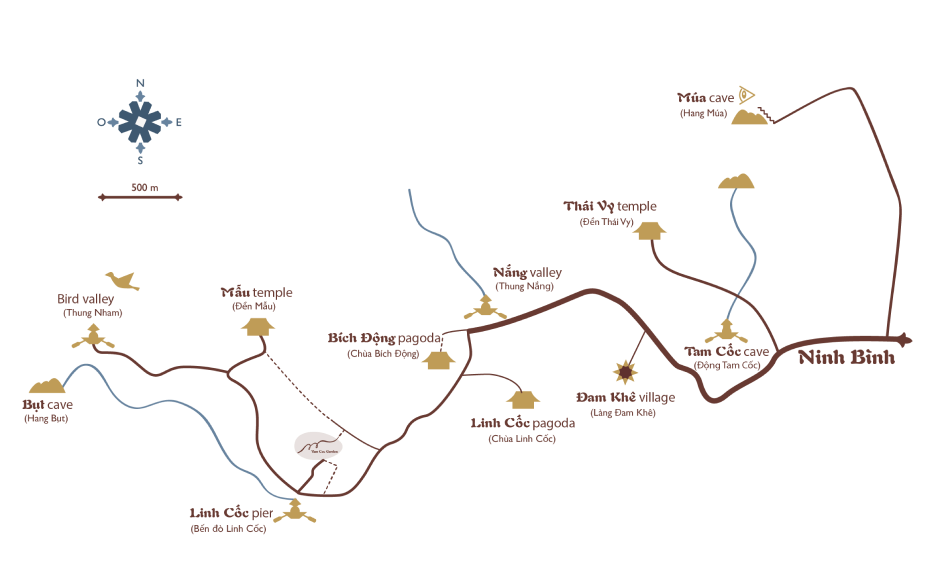
Đi tìm lại vẻ đẹp được mẹ thiên nhiên ban tặng…

Many must-see tourist attractions are easily accessible from Tam Coc Garden such as: the Buddha cave, also known as Hang But (500 meters); Jade Cave, or Bich Dong (1 km); Thung Nang, or Sunshine Valley (2km); Tam Coc caves (5km); Thai Vi temple (6km); Trang An Cave ( 20km); Bai Dinh Pagoda (20km); Hoa Lu Ancient Royal City (20km); Van Long Nature Reserve (25km); Phat Diem Cathedral (30km); and Cuc Phuong National Park (40km).
Ninh Binh Province

Van Long, located 25 km from Tam Coc Garden is a nature reserve that has a higher level of protection than...
Read moreSimilar to Tam Coc Cave, Trang An Cave began to attract guests since its opening in 2010.
Read moreThe caves of Tam Coc are so famous that they are often referred to as “Ha Long Bay on land”
Read morePhat Diem Cathedral is located 35 km from Tam Coc garden. The road connecting Ninh Binh and Phat Diem
Read moreFrom 968 till 1009, Hoa Lu was the capital of Vietnam before it was replaced by Thang Long in 1010
Read moreLocated 20 km from Tam Coc garden, Bai Dinh is a complex of Buddist temples opened in 2010
Read moreLocated 80km southwest of Hanoi, the Cuc Phuong national park is a tropical rain forest that covers an area of 22,2000 hectare
Read more

Van Long Nature Reserve
Van Long, located 25 km from Tam Coc Garden is a nature reserve that has a higher level of protection than other tourist sites in Ninh Binh. Van Long’s landscape resembles that of Tam Coc but it is wilder. A variety of wildlife including swans, kingfishers and storks can be spotted in Van Long.
Trang An cave
Similar to Tam Coc Cave, Trang An Cave began to attract guests since its opening in 2010. Compared to Tam Coc, Trang An is more artificial. It takes more time to visit Trang An than Tam Coc. Main points of interest in Trang An include 9 gorgeous caves of stalactites and stalagmites as well as different temples and pagodas.
Tam Coc cave
The caves of Tam Coc are so famous that they are often referred to as “Ha Long Bay on land”. It takes an hour and a half by boat along the Ngo Dong River to visit the caves. The route includes floating through three natural caves (Hang Cả, Hang Hai, and Hang Ba), the largest of which is 125 m long with its ceiling about 2m high above the water. The boats are typically rowed by one or two local women who also sell embroidered goods.
From Tam Coc Garden, guests can access Tam Coc Cave by bike.
Phat Diem Cathedral
Phat Diem Cathedral is located 35 km from Tam Coc garden. The road connecting Ninh Binh and Phat Diem is marked with various churches that evoke the image of French countryside in the 19th century.
Built in 1891 by Father Six in a Buddhist – pagoda and Catholic – church style of architecture, the Cathedral was formed by dozens of monuments of wood and stone, the principal material used for construction. In its time, Phat Diem Cathedral was an elite stone carving artwork whose effect is ubiquitous in its curved entrance, high towers and sanctuaries. It also enlivens stories of the Bible that are well – preserved in the Christian tradition.
A trip to Phat Diem will not only provide insights into the rich history of Catholicism but also lead to the discovery of an exceptional architecture masterpiece and typical rural Vietnamese landscape.
Hoa Lu Ancient Royal City
From 968 till 1009, Hoa Lu was the capital of Vietnam before it was replaced by Thang Long in 1010. Nowadays, the ancient citadel no longer exists and few significant vestiges remain including 2 temples built in honor of the Dinh dynasty and one that used to rule the country during that period..
In 963, following the death of Ngo Quyen’s second son, the kingdom fell into anarchy and was divided into 12 lords. A few years later, they were eliminated by Dinh Bo Linh, the governor of the province known today as Ha Tinh and the man of 10000 victories who, after a quarter century of political anarchy managed to silence the great feudal lords
In 968, before renaming the country Dai Co Viet, Dinh Bo Linh declared himself emperor under the name of Dinh Tien Hoang which is now given to one of the streets surrounding the Restored Sword Lake in Hanoi. To escape from the threat of the North, the new emperor moved the capital to Hoa Lu, the lower delta, for both strategic and political reasons. After the assassination of Dinh Bo Linh and his son in 979, the power was delegated to General Le Hoan and then to his son who reigned in Hoa Lu until 1010.
The interest of Hoa Lu lies not only in its rich history but also in its serene landscape that represents the living environment of the Red River Delta. Hoa Lu is accessible by taking a 30-minute drive or cycling along the scenic path past villages, paddy fields and piton rocks.
Bai Dinh Pagoda
Located 20 km from Tam Coc garden, Bai Dinh is a complex of Buddist temples opened in 2010 after 10 years of construction. The pagoda is an architectural masterpiece built in a Pharaonic style amid multiple limestone peaks..
It holds several national records; it is the largest pagoda with the biggest bell (20 tons) and possesses the highest number of stone statues.
Cuc Phuong national park
Located 80km southwest of Hanoi, the Cuc Phuong national park is a tropical rain forest that covers an area of 22,2000 hectare and a buffer zone of 6550 hectares.
Cuc Phuong has an amazing diversity of flora and fauna; there are 97 species of mammals, 300 species of birds, 36 species of reptiles, 17 species of amphibians, 11 species of fish, 2,000 species of aquatic plants and thousands of insect species, many of which are listed as endangered species in Vietnam’s Red Data Book.



Tam Coc Area
Thung Nham is a wide valley where various white stocks build their nests.
Read moreThung Nang (Valley of the Sun)
Situated approximately a km from Tam Coc Garden amid spectacular scenery of temples and cave...
Read moreSituated in the village of Van Lam, Thai Vi, 4 miles from Tam Coc garden is one of the oldest temples in Vietnam.
Read moreThis small limestone mountain-surrounded pagoda overlooks rolling rice fields and houses a fairy cave
Read moreLinh Coc jetty is just 300 meters from Tam Coc Garden. From here, guests can embark on a 90 minutes boat
Read moreSituated a km from Tam Coc garden, Bich Dong is one of most popular tourist destinations in Ninh Binh
Read more


Thai Vi temple
Situated in the village of Van Lam, Thai Vi, 4 miles from Tam Coc garden is one of the oldest temples in Vietnam.
Following the victory of the Tran dynasty’s king against the Mongols in 1258, Thai Vi Temple was built in the 13th century in the remembrance of Tran Thai Tong, the king who later left the throne for his son and devoted himself to Buddhism. It was dedicated to the worship of the early kings of the Tran Dynasty which lasted from 1225 to 1400, as well as the generals, namely Tran Hung Dao and Tran Quang Khai who led the resistance against Mongol aggression.
The temple is located in the middle of rice fields and limestone peaks in a calm and serene atmosphere. It has an original stone architecture that follows the principles of Oriental geomancy.
A bike ride from Tam Coc Garden is a great way to enjoy the beautiful scenery and to discover the local lifestyle.
Linh Coc Pier
Linh Coc jetty is just 300 meters from Tam Coc Garden. From here, guests can embark on a 90 minutes boat tour past rice fields, reeds and limestone peaks to the cave of the Buddha, whose name is attributed to the large stone of the lying Buddha found inside the cave. A lovely trip that is not to be missed.
Bich Dong Pagoda
Situated a km from Tam Coc garden, Bich Dong is one of most popular tourist destinations in Ninh Binh. It comprises three structures: Hạ, Trung, and Thượng Pagodas, in ascending order that were built in the 18th century. The cave was a backdrop of the film “Indochine” that featured a magical, surreal place where 2 fugitives came for shelter. The first pagoda was backed by mountains in the middle of a lush garden. The second pagoda is accessible by a small stair and the third pagoda houses 3 Buddas. From here, guests can enjoy a panoramic view of surrounding rice fields and limestone mountains.





